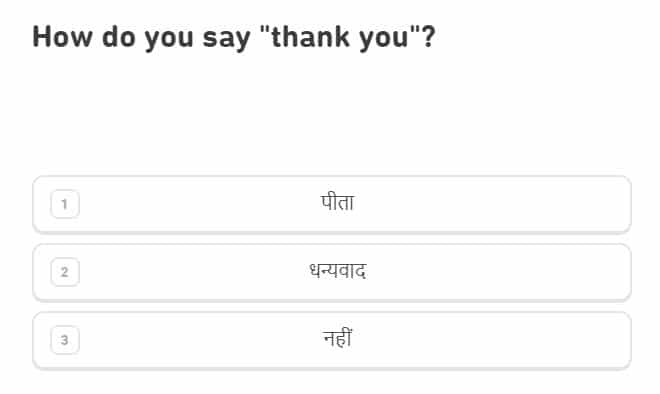Duolingo, a popular language-learning platform, has captured the attention of millions worldwide with its gamified approach to language acquisition. As students advance through the levels , they develop new abilities and solidify their command of the intended language. However, the possibility of bypassing stages in Duolingo becomes alluring for individuals eager to advance their learning or who already have a strong command of the language. This article will discuss how to skip levels in Duolingo, giving them a clear path for moving forwards quickly on the platform.
How Do You Skip Levels in Duolingo App/Website?
- Login to your account (or open the app) & head over to the learn section.
- You will see all the units (lessons) of your selected language.
- Suppose you want to skip to level 5, then you will scroll until you see Unit no. 5.
- You will see a “Jump Here?” prompt next to the first chapter button of lesson 5. Click on that.

- On the next page, Duolingo will ask again- Want to jump to Unit 5? Click on Let’s Go.

- After that, the lesson will start with some questions related to that skip level. You have to pass the test successfully to make a skip.

- The test is not going to be that easy. The questions become difficult as you proceed. When you clear it successfully, you will see this screen: (click on continue 4 times)

- Finally, you will get to see that you have successfully unlocked the lesson no. 5. Continue again.

- If you even feel that you want to revisit those skipped lessons, you can do that anytime. Else, you can restart the Duolingo language for a fresh start.
Understanding Duolingo Levels
Duolingo uses a levelling system to assess users’ language skills and monitor their progress. Each language course is broken down into a number of levels, beginning with the fundamentals and then moving on to more complicated ideas and terminology. These levels act as benchmarks, showing the learner’s development and capacity for taking on new tasks.
Duolingo provides a range of tasks at every level to improve language proficiency. These activities come in a variety of forms, including listening to audio prompts, solving word puzzles, and translating words. Users advance to the next level as they gain experience points (XP) for effectively completing workouts.
Importance
A controlled and progressive learning environment is offered by Duolingo’s levelling system. Before going on to more complex subjects, it makes sure that students have a firm foundation in the fundamentals. Users can develop a thorough comprehension of the language as they go through the stages, thanks to the activities’ increasing difficulty.
Additionally, Duolingo levels are often made up of many skills or modules. These abilities concentrate on certain linguistic features, such as grammatical conventions, vocabulary topics, or colloquial expressions. Learners prove their mastery of a given subject by achieving all the abilities in a level, which unlocks the next level.
The levelling mechanism in Duolingo encourages learning since it gives users a concrete feeling of progress and accomplishment. Users get gems and awards as they gain XP and advance through levels. This helps to motivate them on their language-learning journey. The site also has a scoreboard function that lets users compare their progress with that of friends or other users, encouraging friendly rivalry.
It is essential for users to understand the importance of levels in Duolingo in order to successfully traverse the language-learning process. It works as a barometer for language competence, a growth roadmap, and a guarantee of thorough language comprehension. The basic structure and intent of these levels should be kept in mind while we discuss ways for skipping levels in Duolingo since they serve as the foundation for a platform-optimized learning experience.
Can You Skip Levels in Duolingo?
Yes, it is possible to skip levels in Duolingo through various methods and features provided by the platform. Duolingo provides ways to skip levels for learners with previous language skills.
While skipping levels might speed up development, it’s crucial to find a balance between doing so and strengthening your comprehension. If you skip too many courses without gaining enough competence, you can have gaps in your knowledge or have trouble with subsequent classes. It is recommended to do an accurate assessment of your language ability and decide which levels to skip depending on your skills.
By skipping levels in Duolingo, language learners can make their learning fit their needs, make the most of their time, and focus on the areas where they can make the most progress.
Also See: Leagues on Duolingo app
What Does a skip do in Duolingo?
A skip in a language course on Duolingo is the act of avoiding or skipping over certain levels or competencies. When you go on in the course without doing all the exercises or lessons for a level or skill, you are basically skipping that level or skill.
When you skip a level, you auto-complete all the levels upto that lesson or chapter. However, you can always have a review of those skipped lessons at anytime.
For students who are proficient in the language already or who prefer to concentrate on more advanced material, skipping levels or skills might be advantageous. Users may adjust their learning experience to fit their skills and objectives, which helps them get through the course more quickly.
By bypassing levels, students can gain access to more difficult content that complements their prior knowledge or focuses on their areas of interest. It helps students avoid reviewing material they have previously learned and gives them the chance to experiment with new ideas and language at a suitable level of difficulty. For dedicated students who want to fasten their language learning process, this strategy is quite helpful.
It’s crucial to remember that it’s best to often skip levels or talents. Finding the right mix between skipping and solidifying your comprehension is crucial. If you skip too many courses without gaining enough competence, you can have gaps in your knowledge or have trouble with subsequent classes. It’s best to precisely gauge your degree of language competence and decide which levels or skills to skip depending on your abilities.
Advantages and Disadvantages of Skipping Levels
Advantages of Skipping Levels in Duolingo:
- Time Saving: By avoiding material that they are already acquainted with or have mastered, learners may save time by skipping levels. They can focus on harder topics and go through the course more quickly.
- Targeted Learning: By skipping levels, learners can tailor their language learning experience to their specific needs and interests. They can pay more attention to areas that need it or learn more about more difficult things that fit with their language goals.
- Engagement and Motivation: Moving through levels fast can increase engagement and motivation. Skipping levels gives learners a feeling of success and inspires them to continue enthusiastically on their language learning journey.
- Recognition of Prior Knowledge: Skipping levels recognises and recognises the linguistic skills that learners already possess. It enables students who have previous language experience or expertise to show off their skills and begin the course at a more suitable level.
Disadvantages and Considerations of Skipping Levels in Duolingo:
- Knowledge Gaps: If a level is skipped without demonstrating appropriate competence, knowledge gaps may emerge. It’s possible for learners to overlook vocabulary or fundamental ideas that are crucial for developing a solid linguistic foundation. Before moving too hastily, it’s critical to acquire a firm mastery of the foundations.
- Complexity Adjustment: As students go through levels, the complexity of the activities and teachings rises. When students skip levels, they could come into material that is much more difficult than what they are expecting, which might cause them to feel frustrated or unmotivated.
- Unsatisfactory Learning Experience: Every level in Duolingo has been carefully created to provide a satisfying learning experience. By losing out on important exercises, practise chances, and exposure to various language abilities, level-skipping may impede the growth of a language as a whole.
- Lack of Reinforcement: Completing the activities and lectures at each level helps in strengthening linguistic ideas and abilities. Skipping levels might reduce the amount of information reinforcement, making it harder to remember and use what has been learned.
Duolingo Jump Here not Working
If you’re having trouble with Duolingo skip button, there are a few possible causes and steps you can try:
Check for Updates: Ensure that you have the latest version of the Duolingo app or that your web browser is up to date. Older versions could have compatibility problems that would interfere with the “Jump Here” feature’s use.
If you are trying to utilise the “Jump Here” option of Duolingo Plus, make sure your membership is still active.
If you plan to use Duolingo, make sure your internet connection is steady. Some features, like the ability to jump to a different level, can’t work right if the connection is bad or goes in and out.
Clear Cache and Cookies: Try cleaning your browser’s cache and cookies if you’re using Duolingo on a web browser. Occasionally, accumulated data might prevent certain features from working properly. Restart your browser after clearing the cache, then attempt to use the “Jump Here” option once again.
Should you skip levels in Duolingo?
Level skipping in Duolingo is a personal decision that relies on a number of variables. Although there may be benefits to skipping levels, it is crucial to thoroughly assess any ramifications and disadvantages. When determining whether to skip levels in Duolingo, keep the following in mind:
- Prior Language expertise: Skipping stages may be advantageous if you have prior knowledge or expertise in the target language. By skipping through information you are already acquainted with, you can focus on harder material while saving time.
- Time Restrictions: If you are pressed for time or have special language learning objectives, bypassing stages might speed up your progress. It allows you to focus on things like complex vocabulary or niche subjects that call for extra attention or fit your own demands.
- Skipping levels might give you a feeling of achievement, which can increase your confidence and drive. It enables you to see concrete results and can sustain your interest and motivation in your language-learning endeavours.
- Knowledge Gaps: If a level is skipped without demonstrating appropriate competence, knowledge gaps may emerge. Before moving too swiftly forwards, it’s important to acquire a firm comprehension of the basic principles. Long-term language competency requires laying a solid foundation.
- Adjustment for challenge: The challenge of each level in Duolingo becomes harder. By skipping stages, you can come into material that is far more difficult than what you are expecting, which might cause irritation or demotivation. It’s crucial to establish a balance between difficulty and understanding.
- Learning Style and Retention: Consider how skipping levels aligns with your learning style. Some learners benefit from a more gradual progression, allowing concepts to solidify over time. Others benefit by learning at a quicker rate. Consider how level-skipping could impact your capacity to remember and put what you’ve learnt into practise.
Conclusion
In conclusion, language learners might discover the ability to skip levels in Duolingo to be a useful tool for customizing and making the most of their learning time. Skip levels only after thoroughly weighing the pros and downsides.
For a complete language learning journey, it’s important to find a mix between pushing yourself and reviewing what you already know. Duolingo’s skip-level chances and constant practice can help learners accomplish their language objectives quickly while building a strong foundation.
FAQs
The option to skip levels may vary depending on the language course. While it is available for many popular languages, not all courses offer the skip-level feature. Check the specific language course in Duolingo to see if skipping levels is an option.
Consider your language proficiency, prior knowledge, and learning goals. If you already have a strong grasp of the basics or find certain levels too easy, skipping may be beneficial. However, ensure you have a solid understanding of the fundamentals before advancing to more complex content.
Level-skipping might speed your development, but it’s crucial to maintain a healthy balance. Too many levels skipped without achieving adequate mastery might result in knowledge gaps or challenges in subsequent classes. Before moving on to the next level, it is advised to correctly analyze your skills and make sure you have a firm grasp of the language.
Yes, you can revisit skipped levels in Duolingo. The platform allows you to review completed levels or return to previous content at any time. This flexibility enables you to reinforce your understanding, fill any gaps, or revise concepts if needed.
If you skip levels, you might get less XP than if you did all of them in order. Even if you decide to skip some levels, Duolingo will continue to monitor your progress and modify the difficulty of the exercises based on how well you perform.

Meet Bill, a French language teacher and blogger who specializes in testing various language learning apps. He has been teaching French for nearly 4 decades and holds a Bachelor’s degree from Manhattanville College. With a passion for technology and how it can enhance language learning, Bill has spent years testing and reviewing different language learning platforms. His blog provides valuable insights into the pros and cons of each app, as well as tips for language learners of all levels.
